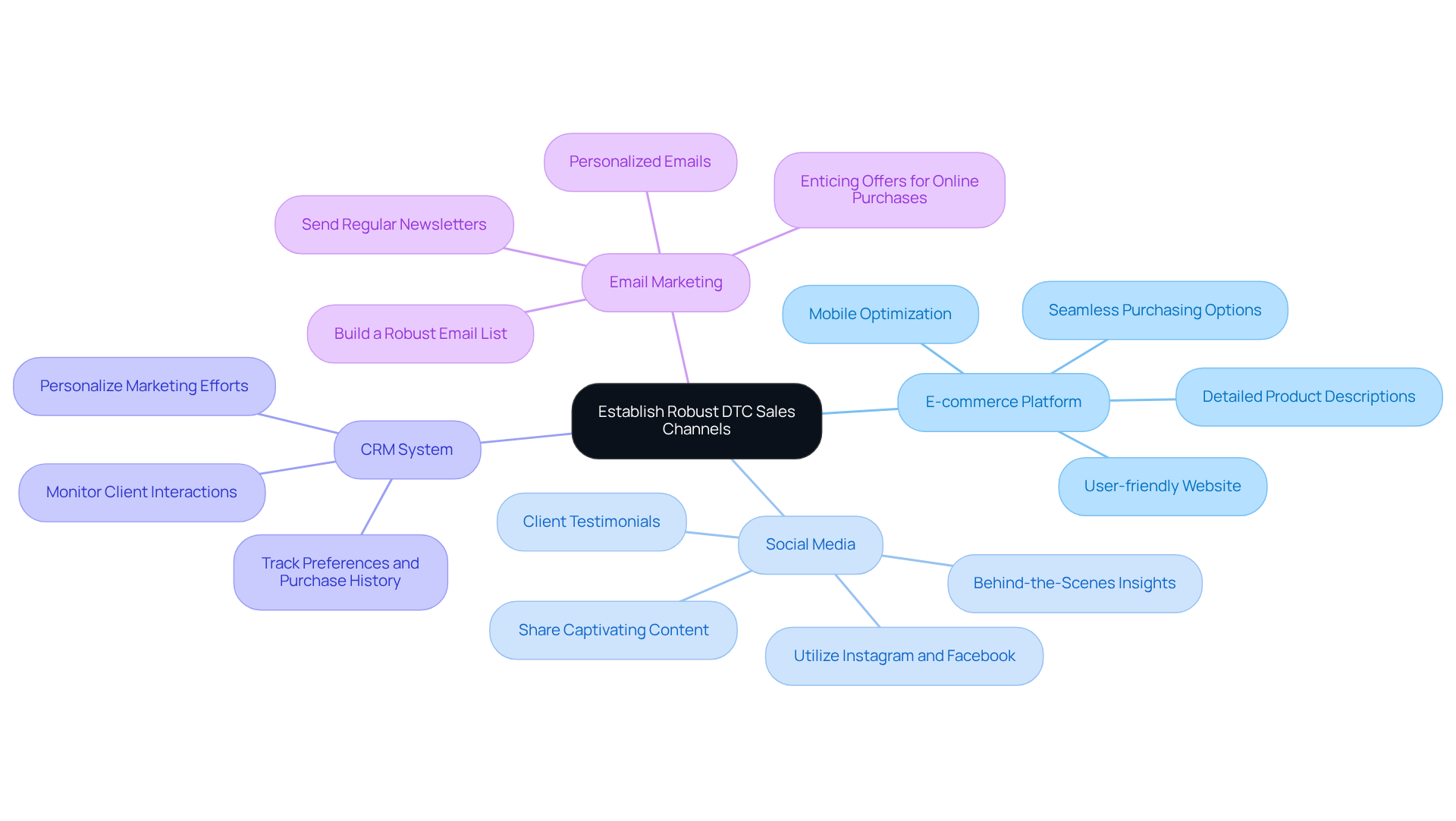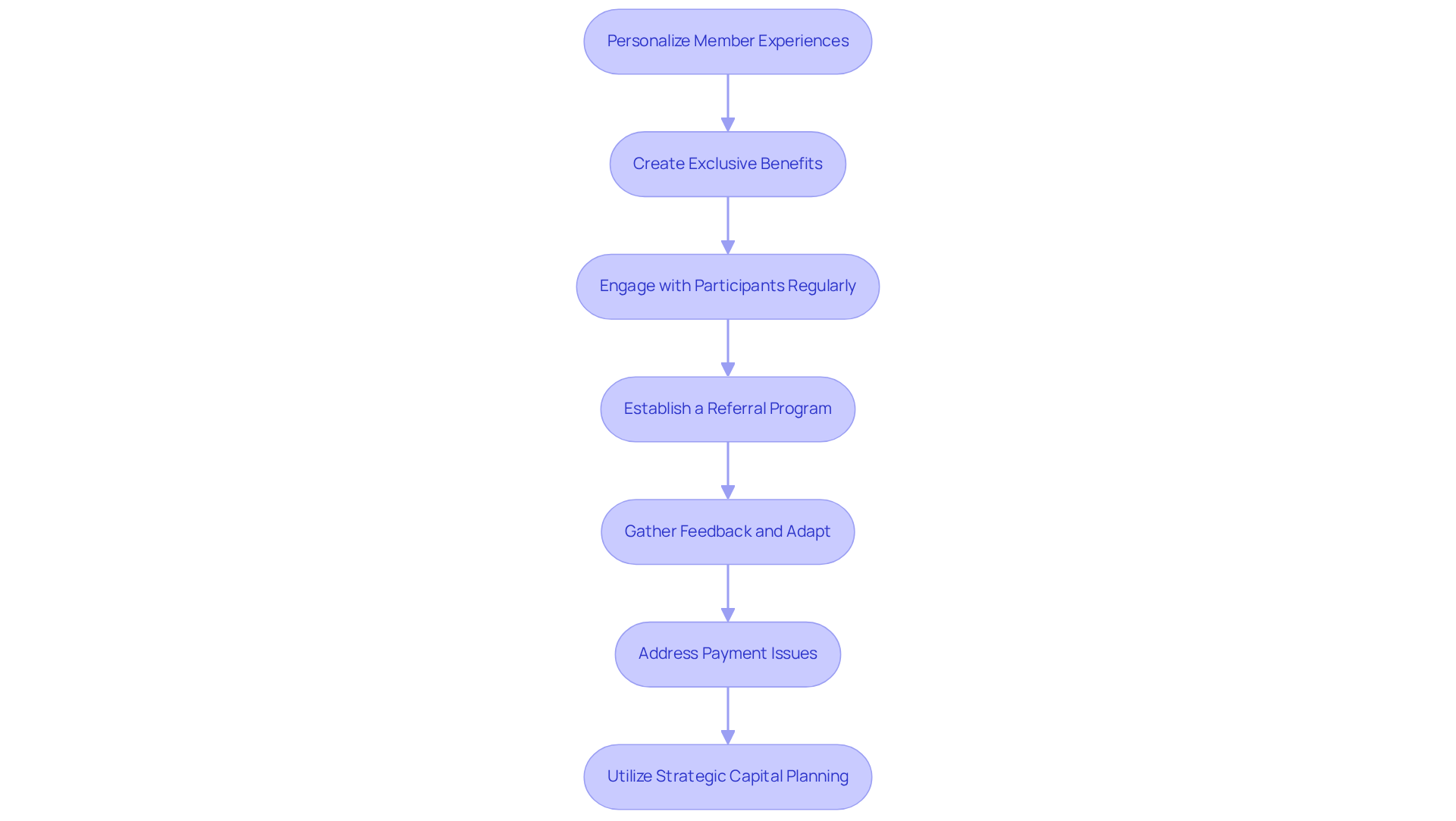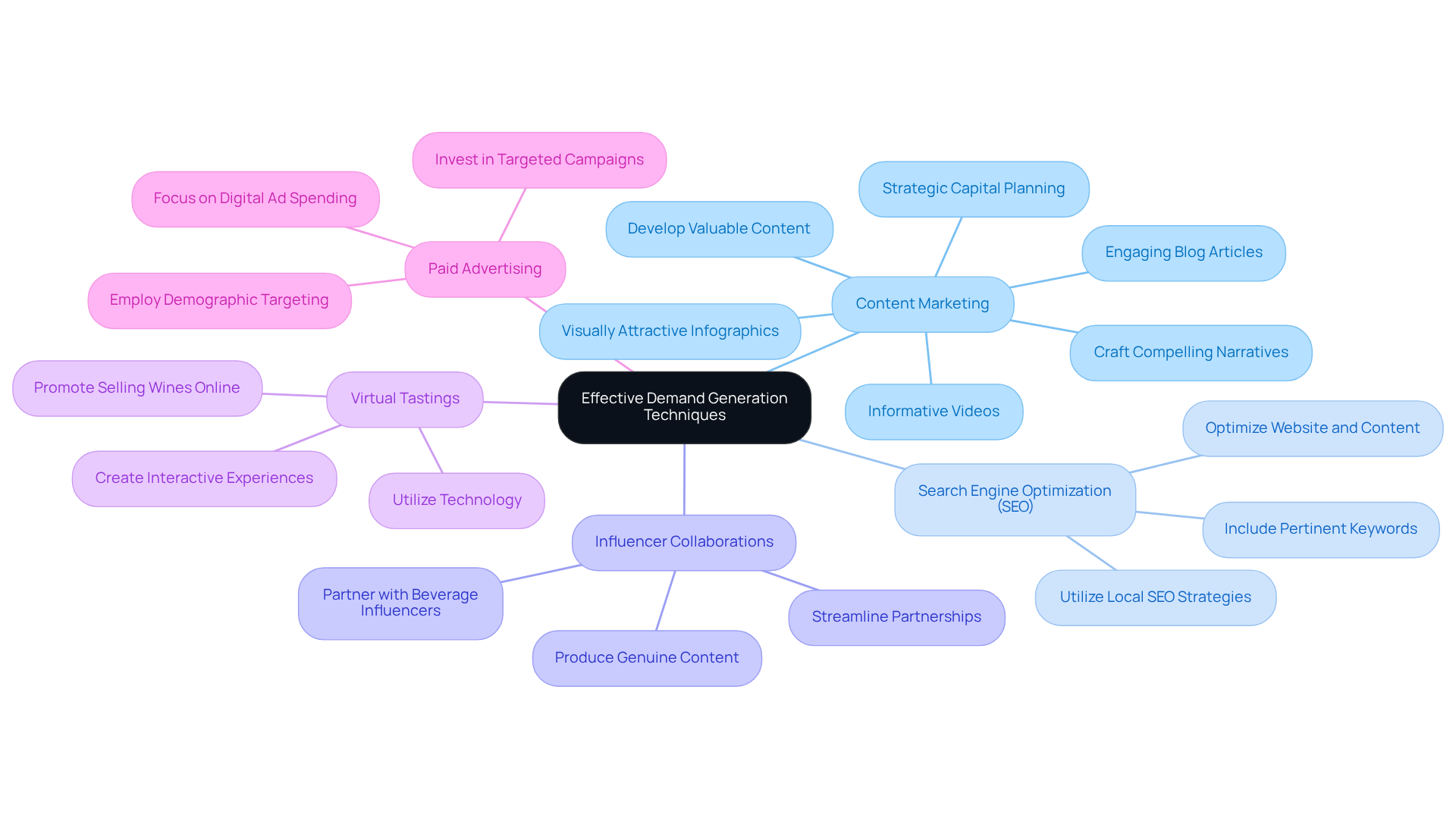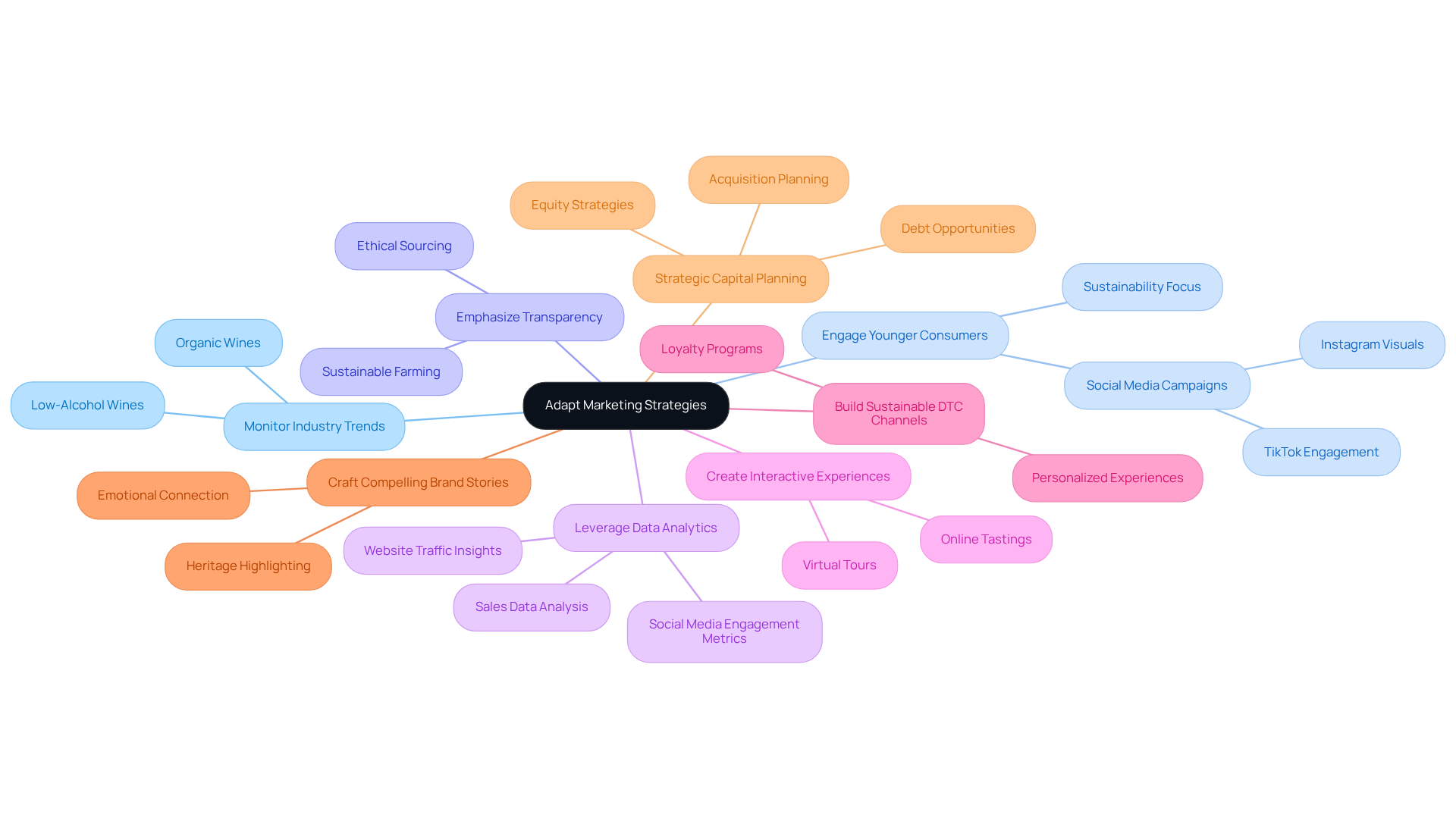Overview
This article presents four proven strategies for effectively selling wines online.
- Establishing strong direct-to-consumer sales channels.
- Optimizing wine club memberships is crucial for enhancing customer loyalty.
- Implementing effective demand generation techniques can significantly boost visibility and sales.
- Adapting marketing strategies to evolving consumer preferences is essential in today’s dynamic market.
These strategies highlight the importance of a user-friendly e-commerce platform that facilitates seamless transactions. Personalized member experiences can foster deeper connections with customers, while engaging content marketing keeps the audience informed and interested. Furthermore, being responsive to market trends is vital for enhancing customer engagement and driving sales. By adopting these strategies, wine businesses can position themselves for success in the competitive online marketplace.
Introduction
Selling wine online presents a unique set of challenges and opportunities that can significantly impact a winery's success. As consumer preferences shift and the digital marketplace expands, wineries must adapt their strategies to effectively connect with customers and drive sales. This article explores four proven strategies that not only enhance direct-to-consumer sales channels but also optimize customer retention and demand generation.
How can wineries leverage these techniques to transform casual buyers into loyal patrons in an increasingly competitive landscape?
Establish Robust Direct-to-Consumer Sales Channels
To establish robust direct-to-consumer (DTC) sales channels, wineries must focus on several key strategies that drive engagement and selling wines online.
- Create an Appealing E-commerce Platform: Investing in a user-friendly website is essential. It should effectively display your products with detailed descriptions and seamless purchasing options. Given that a significant portion of consumers now shop via their smartphones, mobile optimization is critical for enhancing user experience and driving sales.
- Leverage Social Media: Utilizing platforms like Instagram and Facebook is vital for promoting your wines and connecting with your audience. Consistently sharing captivating content, including behind-the-scenes insights and client testimonials, cultivates a community around your brand and strengthens loyalty.
- Implement a CRM System: A Client Relationship Management (CRM) system is indispensable for monitoring client interactions, preferences, and purchase history. This data empowers vineyards to personalize marketing efforts, enhancing customer engagement and retention.
Creating enticing offers for online purchases, such as discounts for first-time buyers or free shipping on orders over a certain amount, can motivate consumers to engage in selling wines online directly from your establishment rather than through retailers.
- Utilize Email Marketing: Building a robust email list and sending regular newsletters featuring new releases, promotions, and updates from the vineyard is crucial. Personalized emails significantly enhance client loyalty and encourage repeat purchases, making a powerful tool in your DTC strategy.

Optimize Wine Club Memberships for Customer Retention
To optimize wine club memberships effectively, wineries must adopt best practices that not only enhance member experiences but also drive growth.
- Personalize Member Experiences: Tailoring wine selections based on individual preferences and previous purchases significantly enhances client satisfaction. Customized deliveries elevate the overall experience and lead to increased retention rates, as individuals feel appreciated and understood. This approach transforms casual buyers into devoted club participants—a proven strategy for maximizing customer loyalty.
- Create Exclusive Benefits: Offering members exclusive access to limited-edition wines, special events, or discounts on additional purchases adds substantial value to their membership. Research indicates that 43% of U.S. adults cite discounts as the primary reason for signing up for subscription services. Such benefits not only promote loyalty but also motivate participants to remain engaged with the establishment, driving steady growth in direct-to-consumer channels.
- Engage with Participants Regularly: Consistent communication is essential for sustaining participant interest. Utilize newsletters, social media, and to share updates about new releases, upcoming events, and behind-the-scenes stories. This continuous involvement keeps participants connected and committed to the winery's narrative, strengthening the brand story that captivates and retains patrons.
- Establish a Referral Program: Encourage current participants to refer friends and family by offering incentives such as discounts or complimentary shipments. This strategy not only aids in naturally expanding the membership base but also reinforces community connections among participants, enhancing the overall customer experience.
- Gather Feedback and Adapt: Regularly solicit feedback from participants to gain insights into their preferences and identify areas for improvement. Leveraging this information enables wineries to refine their products and elevate the overall participant experience, ensuring that the club remains relevant and appealing.
- Address Payment Issues: Proactively resolving payment issues is crucial, as declined payments are a common cause of cancellations. Wineries should follow up with individuals whose payment methods are nearing expiration to prevent accidental cancellations.
- Utilize Strategic Capital Planning: Incorporating strategic capital planning into these practices can facilitate growth opportunities, ensuring that establishments have the resources necessary to enhance client experiences and broaden their offerings.
By concentrating on these strategies, wineries can create a more engaging and personalized experience for their club members, ultimately driving retention and fostering long-term loyalty while strategically planning for future growth opportunities.

Implement Effective Demand Generation Techniques
To implement effective demand generation techniques, wineries must concentrate on the following strategies:
- Content Marketing: Develop valuable content that educates consumers about your wines, the winemaking process, and food pairings. Engaging blog articles, informative videos, and visually attractive infographics can draw in prospective clients while positioning your winery as an industry leader. This approach not only enhances brand visibility for selling wines online but also fosters customer loyalty. Crafting compelling narratives that connect with consumers is essential; your heritage should be perfectly packaged for modern audiences. Additionally, consider how strategic capital planning can support these initiatives by ensuring you have the resources needed for effective content creation.
- Search Engine Optimization (SEO): Optimize your website and content for search engines to improve online visibility. Include pertinent keywords associated with your beverages and the wider sector to draw organic traffic. For instance, wineries that effectively utilize local SEO strategies can significantly enhance their discoverability when it comes to selling wines online, driving more visitors to both their online platforms and physical locations.
- Influencer Collaborations: Partner with beverage influencers and bloggers to expand your reach. Influencers can produce genuine content that highlights your products, motivating their followers to discover your selections. Collaborations can amplify your marketing efforts, especially when influencers share compelling stories that resonate with their audience, transforming casual visitors into loyal customers. Streamlining these partnerships can also be part of your strategic capital planning, ensuring you maximize your marketing budget.
- Host virtual tastings to promote selling wines online, allowing consumers to sample your beverages from the comfort of their homes. This interactive experience creates enthusiasm and motivates participants to buy the highlighted beverages. By utilizing technology, vineyards can craft unforgettable experiences that strengthen consumer connections and boost loyalty, ultimately fostering sustainable growth.
- Utilize Paid Advertising: Invest in targeted online advertising campaigns on platforms like Google and social media. Employ demographic and interest-based targeting to reach potential customers who are likely to be interested in your wines. With in the alcoholic beverage sector rising notably, this strategy for selling wines online can produce substantial returns on investment, enhancing your establishment's visibility in a competitive market.

Adapt Marketing Strategies to Evolving Consumer Preferences
To effectively adapt marketing strategies to evolving consumer preferences, wineries must employ several key approaches:
- Monitor Industry Trends: Staying informed about emerging trends, such as the increasing popularity of low-alcohol and organic wines, is crucial. Modifying product selections and advertising communications in reaction to these trends will assist vineyards in remaining relevant.
- Engage Younger Consumers: Craft marketing campaigns that resonate with younger demographics by emphasizing sustainability, unique experiences, and social media engagement. Platforms like TikTok and Instagram are particularly effective for reaching this audience, prioritizing visual content and community interaction.
- Emphasize Transparency: Today's consumers place a high value on transparency regarding sourcing and production practices. Highlighting sustainable farming methods and ethical sourcing in marketing materials builds trust and attracts conscientious buyers.
- Leverage Data Analytics: Utilizing data analytics to gain insights into consumer behavior and preferences is essential. By analyzing sales data, website traffic, and social media engagement, vineyards can refine their marketing strategies and better target their audience.
- Create Interactive Experiences: Offering interactive experiences, such as virtual tours or tastings, allows consumers to engage with the brand in meaningful ways. These experiences enhance brand loyalty and encourage repeat purchases, fostering a deeper connection with the winery.
- [Build Sustainable DTC Channels](https://enocap.com): Implement proven strategies to transform casual buyers into loyal club members, ensuring consistent growth in direct-to-consumer revenue. This approach not only enhances customer retention but also aligns with the evolving preferences of consumers seeking personalized experiences.
- Craft Compelling Brand Stories: Utilize storytelling to connect with your audience emotionally. Highlight the unique aspects of your winery and its heritage, which resonate deeply with consumers and foster loyalty.
- Strategic Capital Planning: Consider strategic capital planning for debt, equity, or acquisition opportunities to support growth initiatives. This can provide the necessary resources to enhance marketing efforts and expand reach in the competitive wine market.

Conclusion
Establishing effective strategies for selling wines online is essential for wineries striving to excel in a competitive marketplace. By prioritizing robust direct-to-consumer sales channels, wineries can significantly enhance customer engagement and drive sales. The integration of user-friendly e-commerce platforms, an active social media presence, personalized email marketing, and efficient CRM systems culminates in a comprehensive approach that resonates with consumers and fosters loyalty.
This article outlines several pivotal strategies, including:
- Optimizing wine club memberships to bolster customer retention
- Implementing effective demand generation techniques
- Adapting marketing strategies to meet evolving consumer preferences
Personalization, exclusive member benefits, and regular engagement are critical for maintaining a strong connection with wine club participants. Moreover, leveraging content marketing, SEO, and influencer collaborations can substantially elevate brand visibility and attract new customers. Adapting to industry trends and consumer expectations ensures that wineries remain relevant and appealing to a diverse audience.
Ultimately, the success of selling wines online hinges on a winery's capacity to forge meaningful connections with consumers through tailored experiences and strategic marketing initiatives. By embracing these proven strategies, wineries can not only drive sales but also cultivate a loyal customer base that appreciates their unique offerings. The wine industry is evolving, and those who prioritize direct-to-consumer relationships and innovative marketing approaches will undoubtedly lead the way in this dynamic landscape.
Frequently Asked Questions
What are the key strategies for establishing direct-to-consumer sales channels for wineries?
Key strategies include creating an appealing e-commerce platform, leveraging social media, implementing a CRM system, offering enticing online purchase incentives, and utilizing email marketing.
Why is it important to have a user-friendly e-commerce platform?
A user-friendly e-commerce platform is essential because it effectively displays products with detailed descriptions and seamless purchasing options, enhancing user experience and driving sales, especially as many consumers shop via smartphones.
How can social media be used to promote wines?
Social media platforms like Instagram and Facebook can be used to promote wines by sharing captivating content, including behind-the-scenes insights and client testimonials, which helps cultivate a community around the brand and strengthen customer loyalty.
What role does a CRM system play in direct-to-consumer sales?
A CRM system is crucial for monitoring client interactions, preferences, and purchase history, allowing wineries to personalize marketing efforts and enhance customer engagement and retention.
What types of online purchase incentives can motivate consumers?
Incentives such as discounts for first-time buyers or free shipping on orders over a certain amount can motivate consumers to purchase wines directly from wineries instead of through retailers.
How can email marketing benefit wineries?
Email marketing can benefit wineries by building a robust email list and sending regular newsletters that feature new releases, promotions, and vineyard updates, which enhances client loyalty and encourages repeat purchases.




